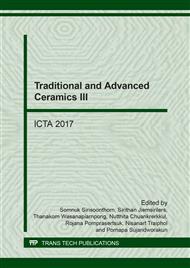[1]
C. Tippayasam., et al., Potassium alkali concentration and heat treatment affected metakaolin-based geopolymer. Construction and Building Materials. 104 (2016) 293-297.
DOI: 10.1016/j.conbuildmat.2015.11.027
Google Scholar
[2]
P. Kaewwichit, J.J., P. Chakartnarodom, C.Tippayasam, T. Srichumpong, P. Thavorniti, C. Leonelli, D. Chaysuwan, Development of microwave-assisted sintering of Portland cement raw meal. Journal of Cleaner Production. 142 (2017) 1252-1258.
DOI: 10.1016/j.jclepro.2016.07.009
Google Scholar
[3]
A. Wongsa., et al., Properties of lightweight fly ash geopolymer concrete containing bottom ash as aggregates. Construction and Building Materials. 111 (2016) 637-643.
DOI: 10.1016/j.conbuildmat.2016.02.135
Google Scholar
[4]
C. Tippayasam., et al., Effect of Thai Kaolin on properties of agricultural ash blended geopolymers. Construction and Building Materials. 53 (2014) 455-459.
DOI: 10.1016/j.conbuildmat.2013.11.079
Google Scholar
[5]
J. Davidovits, J. Thorez and M.H. Gaber. Pyramids of Egypt Made of Man-Made Stone, Myth or Fact?, In Symposium on Archaeometry Smithsonian Institute. Washington D.C., United State, 1984, pp.26-27.
Google Scholar
[6]
J. Davidovits, Geopolymer cements to minimise carbon-dioxide greenhouse-warming. Ceramic Transactions 37,165-182.81. (1993).
Google Scholar
[7]
J. Davidovits, Properties of geopolymer cements, In 1st international conference on alkaline cements and concretes, Scientific Research Institute on Binder and Materials, Kiev State Technical University Kiev, Ukraine, 1994, pp.131-149.
Google Scholar
[8]
F. N. Okoye, J. Durgaprasad, and N.B. Singh, Effect of silica fume on the mechanical properties of fly ash based-geopolymer concrete. Ceramics International. 42 (2016) (2, Part B) 3000-3006.
DOI: 10.1016/j.ceramint.2015.10.084
Google Scholar
[9]
T. Tho-in., et al., Pervious high-calcium fly ash geopolymer concrete. Construction and Building Materials. 30 (2012) 366-371.
DOI: 10.1016/j.conbuildmat.2011.12.028
Google Scholar
[10]
Y. Zaetang., et al., Use of coal ash as geopolymer binder and coarse aggregate in pervious concrete. Construction and Building Materials. 96 (2015) 289-295.
DOI: 10.1016/j.conbuildmat.2015.08.076
Google Scholar
[11]
V. Sata, A. Sathonsaowaphak, and P. Chindaprasirt, Resistance of lignite bottom ash geopolymer mortar to sulfate and sulfuric acid attack. Cement and Concrete Composites. 34 (2012) 700-708.
DOI: 10.1016/j.cemconcomp.2012.01.010
Google Scholar
[12]
V. Sata, A. Wongsa, and P. Chindaprasirt, Properties of pervious geopolymer concrete using recycled aggregates. Construction and Building Materials. 42 (2013) 33-39.
DOI: 10.1016/j.conbuildmat.2012.12.046
Google Scholar
[13]
American Concrete Institute. ACI 522R-10. Report on Pervious Concrete. Michigan, Farmington Hill. (2010).
Google Scholar
[14]
Standard Test Method for Resistance to Degradation of Small-Size Coarse Aggregate by Abrasion and Impact in the Los Angles Machine. ASTM C39-10. Pennsylvania,United Stated. (2001).
DOI: 10.1520/c0131-01
Google Scholar
[15]
A. Elimbi, H.K. Tchakoute and D. Njopwouo, Effects of calcination temperature of kaolinite clays on the properties of geopolymer cements, Construction and Building Materials 25,2805-2812. (2011).
DOI: 10.1016/j.conbuildmat.2010.12.055
Google Scholar
[16]
B. Huang, H. Wu, X. Shu and E.G. Burdette. Laboratory evaluation of permeability and strength of polymer-modified pervious concrete, ConstructionandBuildingMaterials 24(5),818-823. (2010).
DOI: 10.1016/j.conbuildmat.2009.10.025
Google Scholar
[17]
Y. Zaetang, A. Wongsa, V. Sata and P. Chindaprasirt, Use of lightweight aggregates in pervious concrete, Construction and Building Materials 48, 585-591. (2013).
DOI: 10.1016/j.conbuildmat.2013.07.077
Google Scholar


